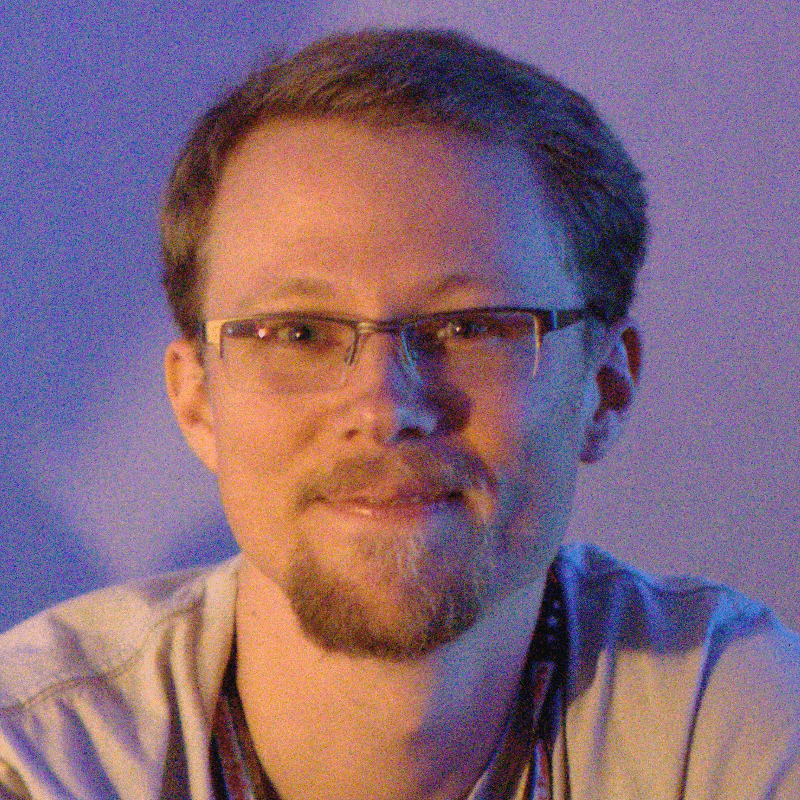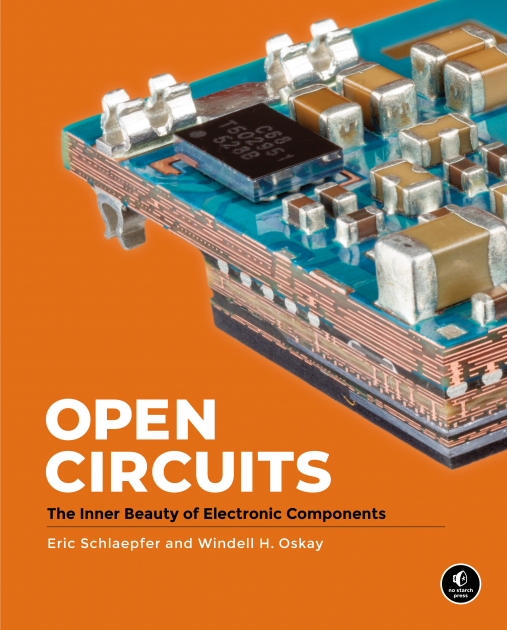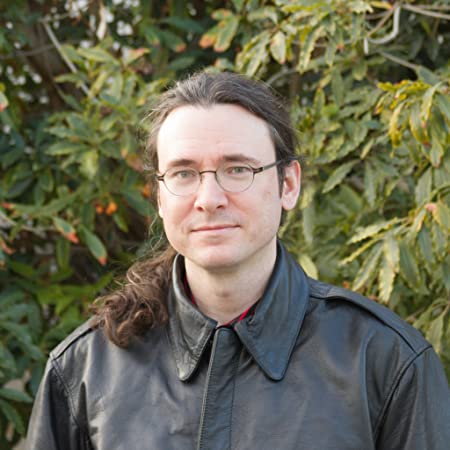Aglow in our Author Spotlight series this month are the daring duo behind Open Circuits: The Inner Beauty of Electronic Components—Windell Oskay and Eric Schlaepfer. Their book is a truly unique photographic exploration of the astonishing design hiding in everyday electronics, and it's as awesome as it sounds. In the following Q&A, we talk with Eric and Windell about how this project came about, the ins and outs of the hardware disassembly and macro-photography feats it took to make the book, the surprises—both good and bad—that they encountered along the way, and the many challenges of cutting a cathode ray tube in two.



Eric is a hardware engineer at Google, and runs the popular Twitter account @TubeTimeUS, where he posts cross-section photos, discusses retrocomputing and reverse engineering, and investigates engineering accidents. His better-known projects are the MOnSter 6502 (the world’s largest 6502 microprocessor, made out of individual transistors) and the Snark Barker (a retro recreation of the famous Sound Blaster sound card).
Windell is the co-founder of Evil Mad Scientist Laboratories, where he designs robots and produces DIY and OS hardware "for art, education, and world domination.” A longtime photographer, he holds a B.A. in Physics and Mathematics from Lake Forest College and a Ph.D. in Physics from the University of Texas at Austin. Besides Open Circuits, he's author of The Annotated Build-It-Yourself Science Laboratory (Maker Media, 2015).
No Starch Press: First of all, congratulations on all the hard work paying off. The response to your book has been incredible. Considering how popular cross-section pictures were when I was a kid, I guess it’s not too surprising. People still love peeking into things full of hidden complexities! But the books I remember were mostly just intricate drawings—for Open Circuits, you actually photographed real stuff that you cut in half. What inspired this project? Did you intend to add a whole new dimension to the “cutaway” genre?
Eric Schlaepfer: I grew up fascinated by cross sections and cutaways. I’m sure that influenced this book, but it’s not exactly what inspired me. It was a broken piece of equipment, and the problem was one of the electrical components (a tantalum capacitor similar to the one on page 40). I sanded it in half to see if I could figure out how it failed, tweeted a photo, and folks really enjoyed it. So I started cutting other parts in half, and that led to the book.
Windell Oskay: I’ve always been interested in how things are made, in addition to how they work and what’s inside them. One of the really remarkable things about physically cutting things is that you get to see so many features that are maybe incidental to the function of the device, but are signatures of the processes that went into making it. Each part tells a story. And, often, we’re not even saying anything about them. Those little stories are left for the readers to discover.
NSP: The two of you have professionally intersected over the years in Silicon Valley, and have worked together on some design projects for Evil Mad Scientist Laboratories. But who roped whom into this book idea? What compelled you to collaborate at such a level?
ES: We’ve worked together on a number of other projects, such as the Three Fives discrete 555 timer kit, as well as the world’s largest 6502 microprocessor—the MOnSter 6502. Windell had seen my photos on Twitter, and we started talking about how to turn it into a book. I don’t remember all the details but it was a very natural thing.
WO: We’ve had a number of fruitful collaborations. In addition to those that Eric mentioned, we also designed an educational project, “Uncovering the Silicon,” that we presented at Maker Faire (along with Ken Shirriff, our technical reviewer for Open Circuits, and John McMaster, who prepared some subjects for photography). In that project, we placed very simple integrated circuits under a microscope and showed how they worked by tracing their individual parts. There’s a sense in which our book is a successor to that project—we’re letting people look at things up close, and then talking through how they work. But, I think that there was actually a moment when I roped Eric into the book idea after seeing his early cross-section photos.
NSP: What was the most challenging aspect of putting this book together?
ES: There were many challenges. For me, the most difficult challenge was preparing the samples—it took a really long time to prepare each one, taking care to create a polished section with no scratches or blemishes, and being careful to remove every speck of dust.
WO: At one point we realized that we would have to cull the weakest subjects from our draft. We ended up deleting about a dozen—some quite interesting and beautiful—along with their descriptive text. The book is stronger as a whole because we did so, but it really stung at the time. Fine-tuning our text was also difficult in places. For a number of subjects, we only had a few sentences in which to flesh out subtle concepts clearly, to an audience composed of both laypeople and engineers.
NSP: How did you divide up all of the labor that the book entailed? I mean, you had to find hundreds of tiny electronic components, carefully cut them in half, photograph them, write the accompanying text for each page—the list goes on and on!
ES: Windell took on the photography and some of the sample preparation, introducing me to some more professional tools that I hadn’t used before. We spent time searching the local electronics surplus store for potential subjects, and I made a lot of exploratory cuts to see if a particular component would be good enough for the book. I’d say the writing was a 50/50 split—we spent so much time writing and editing over video-chat that I wouldn’t be able to point to any sentence and definitively say 'I wrote this.'
WO: In addition to the bulk of the cutting and sample preparation, Eric also drew the rough drafts of all of the illustrations and wrote the initial drafts of some of the most challenging subjects to describe. I took the photographs, fine-tuned the illustrations, and designed the initial page layout so that we could understand how much text could be paired with each photographic subject. And as Eric said, we worked together closely through all of the writing and editorial choices.
NSP: Eric—what was the hardest thing to cross-section, and how did you eventually make it work?
ES: The most challenging was the cathode ray tube (page 186). Windell had the idea to cut it on the slow-speed saw so we could remove the electron gun. I sectioned the glass envelope and the electron gun separately—each of those took several hours to wet sand. The parts were simply too fragile to section any other way. Cleaning the sectioned electron gun was difficult because of the small magnet inside, which vacuumed up the debris created during sanding.
NSP: Windell—unlike a cross-section illustration, capturing everything inside an object with a single photograph in a single frame had to be difficult at times. Can you give us some examples where you had to get creative to get the shot?
WO: One of the basic limitations that you can run into with macro photography is the limited depth of field—only a very narrow slice of the view is in focus at any given time. We used focus-stacking software to digitally combine pictures taken at different camera positions, stitching them together like a panorama where the entire subject is sharp and in focus. The circuit-board photograph on the front cover of the book was taken this way. Other times, the subject itself can just be plain hard to photograph.
For some of the LEDs, like the surface-mount LED on page 90, we took photos at different exposure levels and composited them (in a basic HDR—high dynamic range—process) so that you can see detail even in the brightly lit LED. For the color sensor on page 81, the photos came out drab until we added an additional light source at just the right position and brightness so that you could see the additional reflection.
NSP: How did you decide what samples and images ultimately made it into the book?
ES: During endless hours of video chat we discussed every potential sample and made a highly detailed spreadsheet. We’re both very organized.
WO: Some part of it was determined by which things we could get our hands on—there are probably 50 other things in the spreadsheet that we might have included if we had an example to disassemble. We did skip a number of potential subjects that were too similar to others, too difficult to section, too difficult to photograph, or that were less likely to be of general interest.
NSP: Anyone who’s into photography knows that what’s pleasing to the eye is not always pleasing to the lens. Were there any samples that you successfully cross-sectioned but just could not get a good photo of—things you left on the cutting-room floor, as it were?
WO: Yes, there were quite a few actually, including some that we put a lot of time into preparing. A good example is a reed relay, where we just couldn’t get a photo that clearly showed the features that we wanted to highlight.
NSP: Given that you both have backgrounds in hardware engineering—and professional tinkering in general—did you know in advance which electronic components would look cool from a cross-cutting perspective, or was there a lot of trial and error? Any surprises along the way, good or bad?
ES: I’ve seen a few component cross sections created for failure-analysis purposes, so I knew about certain components that would look good, but there were definitely a few surprises. We thought an RGB LED would look cool, but after cutting into one, it just didn’t really seem interesting. We took apart a boring-looking gray electronics module that turned out to be a fabulously complex jewel—the isolation amplifier (page 266).
WO: One of my favorites that took some experimentation was the multilayer ceramic capacitor (page 36). There’s never been any mystery about what is in one—stacked layers of metal electrodes—but it took us a lot of experimentation and cutting into different capacitors to find one where you could literally see and count the individual layers. There were definitely real surprises along the way. The way that the rocker DIP switch (page 110) works inside is just stunning elegance.
NSP: You include a “Retro Tech” section in the book for your vintage finds, like Nixie tubes, a mercury tilt switch, and even a magnetic tape head. From a purely aesthetic standpoint, which era wins (Old vs. Modern) as far as microscale interior design goes?
ES: They both fascinate me. Vintage components seem warm and natural to me, being made of less processed materials like brass, rubber, mica, and glass. Modern parts have a sort of cold Cartesian precision and a microscopic intricacy.
WO: Modern electronics has so much more to offer in interior design—there’s just so much more inside. If we were talking about exterior design, I’ll pick the vintage. I love all the brass and Bakelite.
NSP: Windell, your company’s motto is “Making the World a Better Place, One Evil Mad Scientist at a Time.” If you had to come up with a similar motto for your book, what would it be? I’ll go first: “Making the garage a messier place, one experiment at a time!” . . . I guess what I’m getting at is, what effect do you hope your work in this book has on people? Eric, same question for you.
WO: If the book needed a motto, other than our existing subtitle, I’d pick “Showing you the Hidden Wonders Inside Electronics.” I hope that it inspires people to open up their electronics and look inside. To look at the parts for the little clues about how they’re made, what they’re for, and how they work. To appreciate elegant design, where they weren’t looking for it before.
ES: I want to inflame curiosity. Earlier today my very young nephew was totally absorbed in a copy of the book, asking his mother afterwards if they had any circuits he could play with. The world is a better place with curious people living in it.
